
The lion is a species in the family Felidae and a member of the genus Panthera. It has a muscular, deep-chested body, short, rounded head, round ears, and a hairy tuft at the end of its tail. It is sexually dimorphic; adult male lions have a prominent mane. With a typical head-to-body length of 184–208 cm (72–82 in) they are larger than females at 160–184 cm (63–72 in). It is a social species, forming groups called prides. A lion pride consists of a few adult males, related females and cubs. Groups of female lions usually hunt together, preying mostly on large ungulates. The lion is an apex and keystone predator; although some lions scavenge when opportunities occur and have been known to hunt humans, the species typically does not.
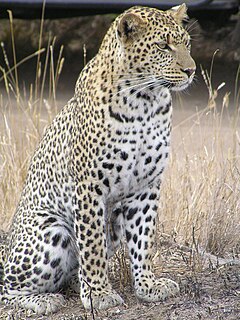
The leopard is one of the five extant species in the genus Panthera, a member of the Felidae. It occurs in a wide range in sub-Saharan Africa, in some parts of Western and Central Asia, Southern Russia, and on the Indian subcontinent to Southeast and East Asia. It is listed as Vulnerable on the IUCN Red List because leopard populations are threatened by habitat loss and fragmentation, and are declining in large parts of the global range. The leopard is considered locally extinct in Hong Kong, Singapore, South Korea, Jordan, Morocco, Togo, the United Arab Emirates, Uzbekistan, Lebanon, Mauritania, Kuwait, Syria, Libya, Tunisia and most likely in North Korea, Gambia, Laos, Lesotho, Tajikistan, Vietnam and Israel. Contemporary records suggest that the leopard occurs in only 25% of its historical global range.
Panthera is a genus within the family Felidae that was named and described by Lorenz Oken in 1816 who placed all the spotted cats in this group. Reginald Innes Pocock revised the classification of this genus in 1916 as comprising the tiger, lion, jaguar, and leopard on the basis of common cranial features. Results of genetic analysis indicate that the snow leopard also belongs to the genus Panthera, a classification that was accepted by IUCN Red List assessors in 2008.

The Barbary lion is an extinct Panthera leo leo population that lived in the Barbary Coast region of the Maghreb from the Atlas Mountains in Morocco to Egypt, but was eradicated following the spread of firearms and bounties for shooting lions. A comprehensive review of hunting and sighting records revealed that small groups of lions may have survived in Algeria until the early 1960s, and in Morocco until the mid-1960s. Today, it is locally extinct in this region.
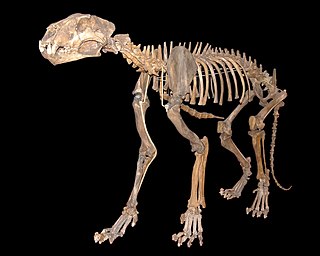
Panthera spelaea, also known as the Eurasian cave lion, European cave lion or steppe lion, is an extinct Panthera species that most likely evolved in Europe after the third Cromerian interglacial stage, less than 600,000 years ago. Phylogenetic analysis of fossil bone samples revealed that it was highly distinct and genetically isolated from the modern lion occurring in Africa and Eurasia. Analysis of morphological differences and mitochondrial data support the taxonomic recognition of Panthera spelaea as a distinct species that genetically diverged from the lion about 1.9 million years ago. Nuclear genomic evidence suggests a more recent split approximately 500,000 years ago, with no subsequent interbreeding with the ancestors of the modern lion. The oldest known bone fragments were excavated in Yakutia and radiocarbon dated at least 62,400 years old. It became extinct about 13,000 years ago.

The American lion, also known as the "North American lion", or "American cave lion", is an extinct pantherine cat that lived in North America during the Pleistocene epoch and the early Holocene epoch, about 340,000 to 11,000 years ago. Its fossils have been excavated from Alaska to Mexico. Genetic analysis has shown that the American lion and the Late Pleistocene Eurasian cave lion are sister lineages. It was about 25% larger than the modern lion, making it one of the largest known felids.

The Cape lion was a Panthera leo melanochaita population in South Africa's Natal and Cape Provinces that was extirpated in the mid-19th century. The type specimen originated at the Cape of Good Hope and was described in 1842.

The Asiatic lion is a Panthera leo leo population surviving today only in India. Since the turn of the 20th century, its range is restricted to Gir National Park and the surrounding areas in the Indian state of Gujarat. Historically, it inhabited much of Western Asia and the Middle East to northern India.
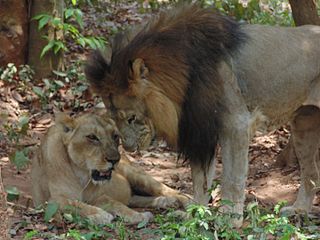
Panthera leo leo is a lion subspecies, which is present in West Africa, northern Central Africa and India. In West and Central Africa it is restricted to fragmented and isolated populations with a declining trajectory. It has been referred to as the 'Northern lion'.

Pantherinae is a subfamily within the family Felidae; it was named and first described by Reginald Innes Pocock in 1917 as only including the Panthera species. The Pantherinae genetically diverged from a common ancestor between 9.32 to 4.47 million years ago and 10.67 to 3.76 million years ago.

The history of lions in Europe is based on fossils of Pleistocene and Holocene lions excavated in Europe since the early 19th century. The first lion fossil was excavated in southern Germany, and described by Georg August Goldfuss using the scientific name Felis spelaea. It probably dates to the Würm glaciation, and is 191,000 to 57,000 years old. Older lion skull fragments were excavated in Germany and described by Wilhelm von Reichenau under Felis fossilis in 1906. These are estimated at between 621,000 and 533,000 years old. The modern lion inhabited parts of Southern Europe since the early Holocene.
The Sri Lankan lion, also known as the Ceylonese lion, is an extinct prehistoric subspecies of lion, excavated in Sri Lanka. It is believed to have become extinct prior to the arrival of culturally modern humans, c. 37,000 years BC. This lion is only known from two teeth found in deposits at Kuruwita. Based on these teeth, P. Deraniyagala proposed this subspecies in 1939. However, there is insufficient information to determine how it might differ from other subspecies of lion. Deraniyagala did not explain explicitly how he diagnosed the holotype of this subspecies as belonging to a lion, though he justified its allocation to a distinct subspecies of lion by its being "narrower and more elongate" than those of recent lions in the British Natural History Museum collection.
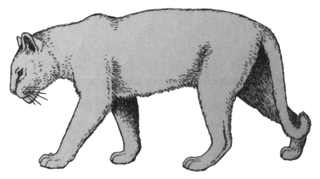
Panthera gombaszoegensis, also known as the European jaguar, is a Panthera species that lived from about 2.0 to 0.35 million years ago in Europe. The first fossils were excavated in 1938 in Gombasek, Slovakia.
Panthera youngi is a fossil cat species that was described in 1934; fossil remains of this cat were excavated in a Sinanthropus formation in Choukoutien, northeastern China. Upper and lower jaws excavated in Japan's Yamaguchi Prefecture were also attributed to this species. It is estimated to have lived about 350,000 years ago in the Pleistocene epoch. It was suggested that it was conspecific with Panthera atrox and P. spelaea due to their extensive similarities. Some dental similarities were also noted with the older P. fossilis, however, Panthera youngi showed more derived features.
Panthera leo fossilis is a fossil cat of the genus Panthera, which was first excavated near Mauer in Germany, and lived during the Upper Pleistocene. Bone fragments of P. l. fossilis were also excavated near Pakefield in the United Kingdom, which are estimated at 680,000 years old. Bone fragments excavated near Isernia in Italy are estimated at between 600,000 and 620,000 years old. The first Asian record of a fossilis lion was found in the Kuznetsk Basin in western Siberia and dates to the late Early Pleistocene.
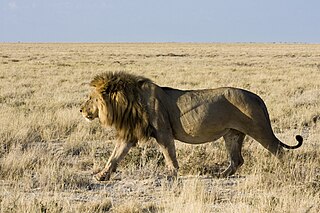
Panthera leo melanochaita is a lion subspecies in Southern and East Africa. In this part of Africa, lion populations are regionally extinct in Lesotho, Djibouti and Eritrea, and threatened by loss of habitat and prey base, killing by local people in retaliation for loss of livestock, and in several countries also by trophy hunting. Since the turn of the 21st century, lion populations in intensively managed protected areas in Botswana, Namibia, South Africa and Zimbabwe have increased, but declined in East African range countries. In 2005, a Lion Conservation Strategy was developed for East and Southern Africa.

Eurasian cave lion may refer to:
Panthera pardus spelaea, sometimes called the European Ice Age leopard or Late Pleistocene Ice Age leopard, is a fossil leopard subspecies, which roamed Europe in the Late Pleistocene. The youngest known bone fragments date to about 32,000 to 26,000 years ago, and are similar in size to modern leopard bones.
Panthera blytheae is an extinct species of the genus Panthera that is thought to have existed during the late Messinian to early Zanclean ages approximately 5.95–4.1 million years ago. It is currently the oldest known Panthera species. The first fossils were excavated in 2010 in the Zanda Basin located in the Ngari Prefecture on the Tibetan Plateau.
Ursus ingressus is an extinct species of the family Ursidae that lived in Central Europe during the Late Pleistocene. It is named after the Gamssulzen Cave in Austria, where the holotype of this species was found.












